Optimization of High-Pressure Ultrasonic-Assisted Simultaneous Extraction of Six Major Constituents from Ligusticum chuanxiong Rhizome using Response Surface Methodology
Abstract
:1. Introduction
| No. | Constituents | Method | Solvent | Time (min) | Temperature (°C) | Extraction yield (%) | Ref. |
|---|---|---|---|---|---|---|---|
| 1 | Ferulic acid | Ultrasound | 4 mL ethanol | 30 | 25 | 0.06 | [9] |
| 2 | Ferulic acid | Reflux | 12 mL 75% ethanol | 270 | 100 | 0.13 | [10] |
| 3 | Ferulic acid | Reflux | 8 mL 70% ethanol | 180 | 100 | 0.11 | [11] |
| 4 | Ferulic acid | Reflux | 7.5 mL 80% ethanol | 180 | Unclear | 0.11 | [12] |
| 5 | Ferulic acid | Percolation and decoction | 12 mL water | 180 | 100 | 0.05–0.06 | [6] |
| 6 | Ferulic acid | Reflux | 6 mL 90% ethanol | 358 | Unclear | 0.14 | [13] |
| 7 | Ferulic acid | Microwave | 10 mL 40% ethanol | 4 | Unclear | 0.08 | [22] |
| 8 | Ferulic acid | Reflux | 54 mL 40% ethanol | 180 | 100 | 0.10–0.19 | [14] |
| 9 | Ferulic acid | Reflux | 5 mL 90% ethanol | 90 | 100 | 0.11–0.18 | [15] |
| 10 | Ferulic acid | Reflux | 5 mL water | 60 | 50 | 0.05 | [16] |
| 11 | Ferulic acid | Reflux | 8 mL 70% ethanol | 180 | 100 | 0.11 | [17] |
| 12 | Ferulic acid Ligustilide | Reflux | 15 mL 80% ethanol | 180 | Unclear | 0.35–0.12; 0.07–0.20 | [18] |
| 13 | Ligustilide | Reflux | 25 mL 71% ethanol | 278 | 89 | 0.68 | [19] |
| 14 | Senkyunolide A Ligustilide | Distillation | water | 540 | 100 | 0.04; 0.21 | [5] |
| 15 | Senkyunolide I Senkyunolide H Ligustilide | Microwave | 15 mL ionic liquid | 5 | 180 | about 0.08; about 0.02; about 0.40 | [21] |
| 16 | Senkyunolide I Senkyunolide H Ligustilide | Reflux | 5 mL 75% ethanol | 270 | 60 | 0.10–0.20; 0.05–0.09; 0.44–0.53 | [20] |
| 17 | Ferulic acid Senkyunolide I Senkyunolide H Ligustilide Levistolide A | Percolation and ultrasound | 25 mL ethanol | >300 | Unclear | 0.51; 1.32; 0.47; 3.74; 0.05 | [7] |
2. Results and Discussion
2.1. Analysis of Single Factor Test Results
2.1.1. Effect of Solvent Type on Extraction

2.1.2. Effect of Pressure on Extraction

2.1.3. Effect of Particle Size on Extraction
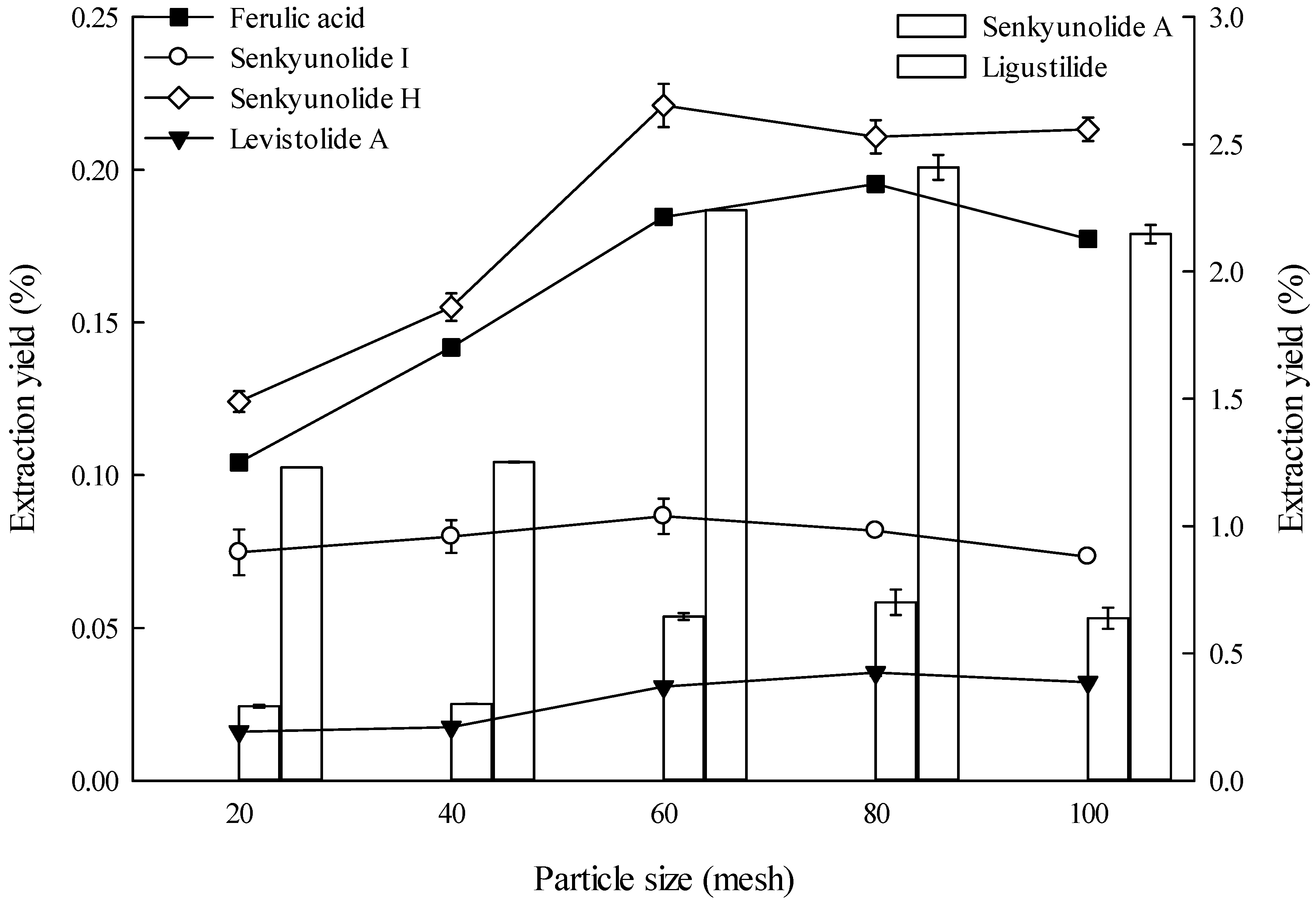
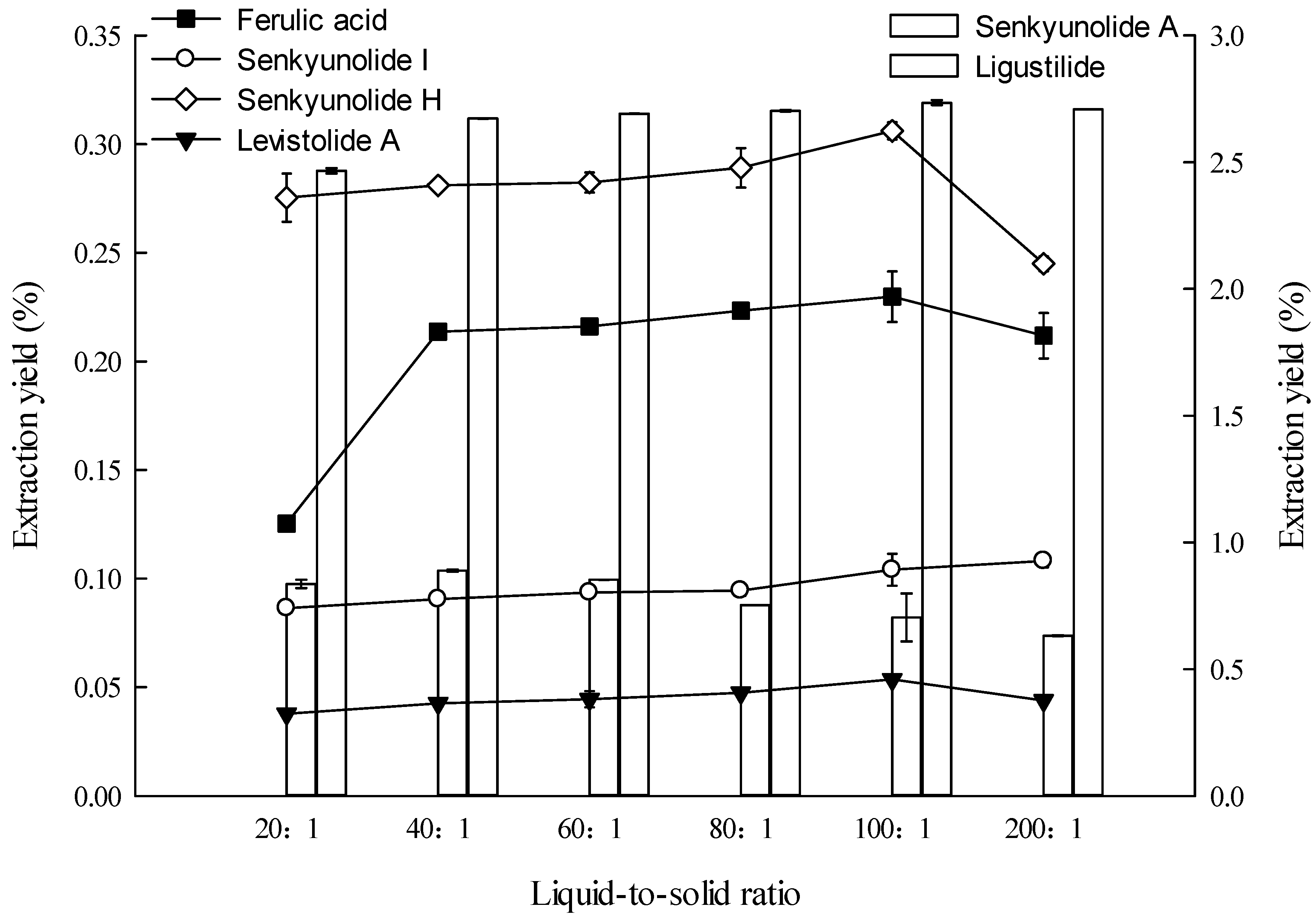
2.1.4. Effect of Liquid-to-Solid Ratio on Extraction
2.1.5. Effect of Temperature on Extraction
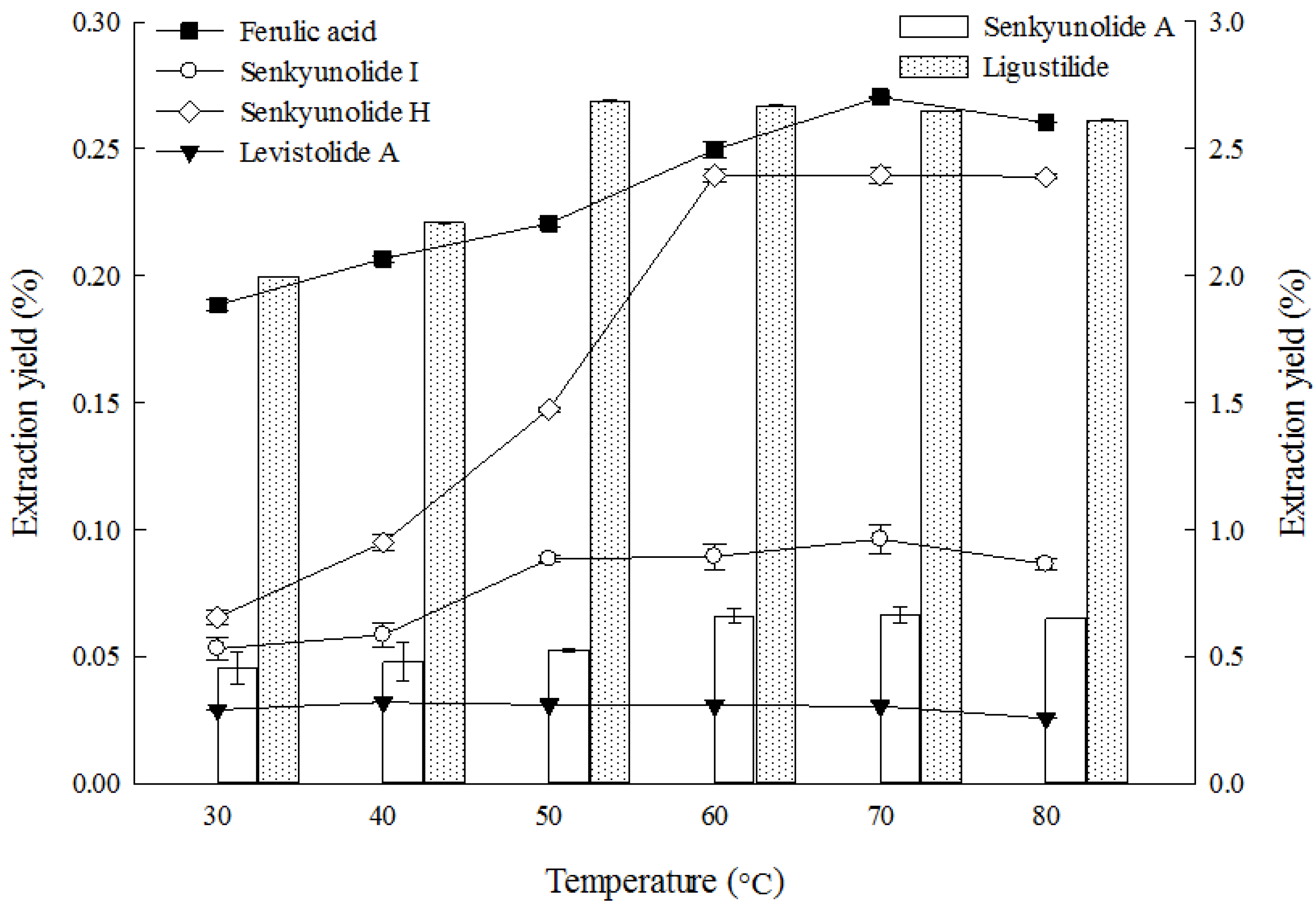
2.1.6. Effect of Ultrasonic Power on Extraction
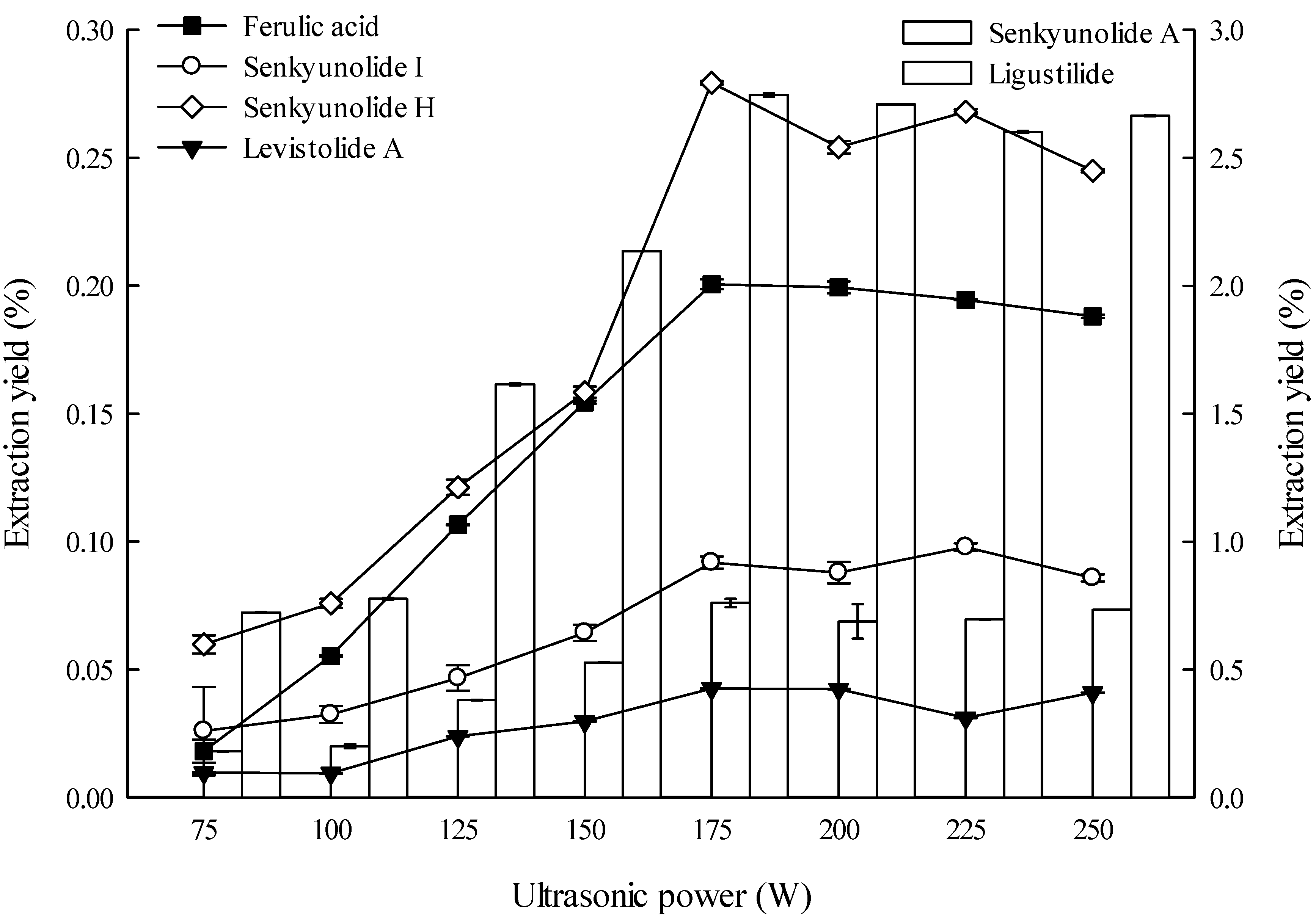
2.1.7. Effect of Time on Extraction
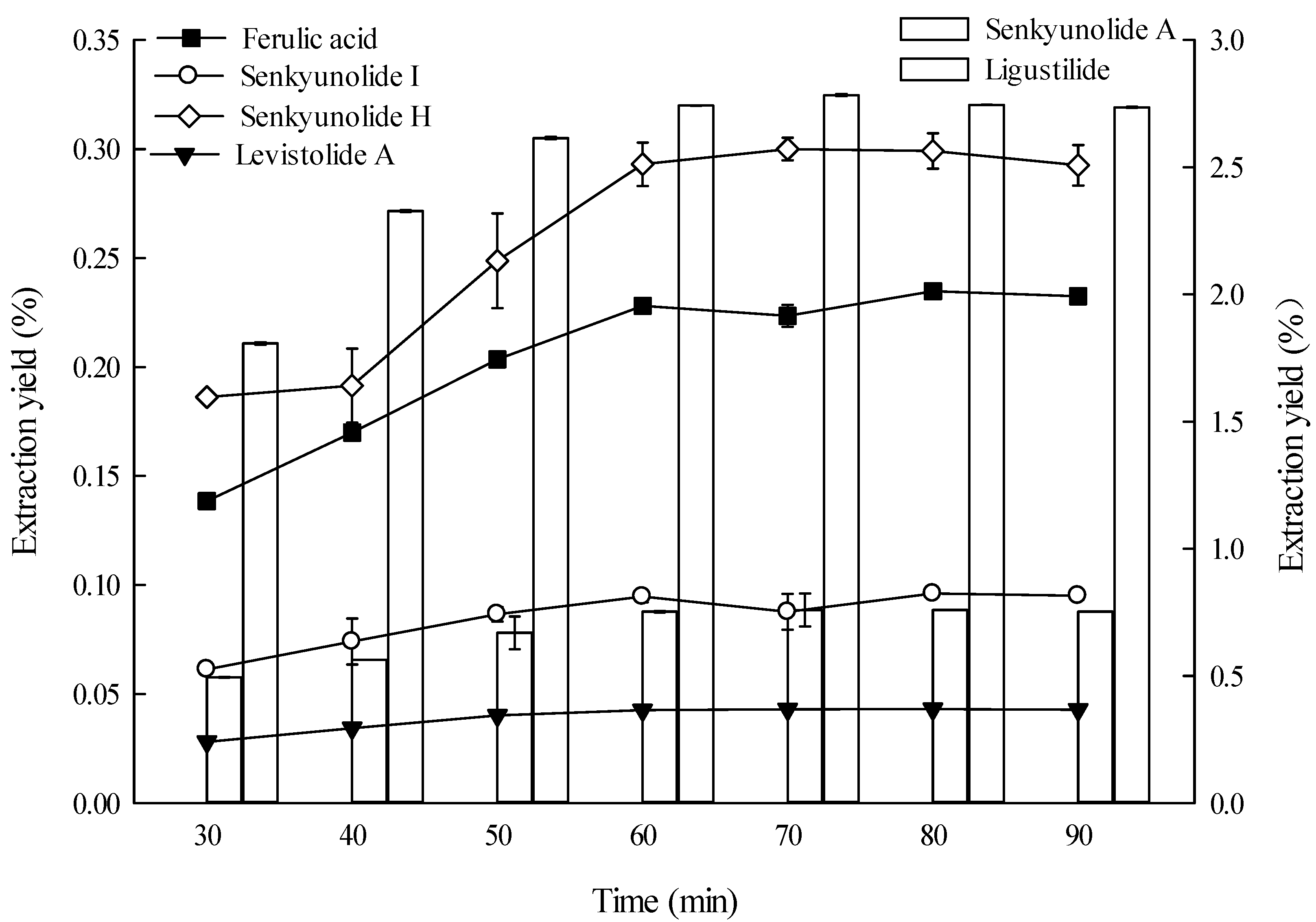
2.2. Model Fitting of Parameters based on the Extraction Yields of the Six Constituents
2.2.1. Effect of Process Variables on the Extraction Yield of Ferulic Acid
| Run order | X1 (°C) | X2 (W) | X3 (min) | Ferulic acid | Senkyunolide I | Senkyunolide H | Senkyunolide A | Ligustilide | Levistolide A |
|---|---|---|---|---|---|---|---|---|---|
| 1 | 1(70) | 1(200) | 1(80) | 0.25 ± 0.01 | 0.09 ± 0.01 | 0.26 ± 0.01 | 0.70 ± 0.00 | 2.65 ± 0.01 | 0.04 ± 0.01 |
| 2 | 1(70) | 1(200) | −1(60) | 0.25 ± 0.01 | 0.09 ± 0.01 | 0.25 ± 0.03 | 0.69 ± 0.03 | 2.63 ± 0.01 | 0.04 ± 0.01 |
| 3 | 1(70) | −1(150) | 1(80) | 0.25 ± 0.01 | 0.09 ± 0.01 | 0.26 ± 0.01 | 0.67 ± 0.00 | 2.63 ± 0.01 | 0.04 ± 0.01 |
| 4 | 1(70) | −1(150) | −1(60) | 0.25 ± 0.01 | 0.08 ± 0.01 | 0.25 ± 0.01 | 0.64 ± 0.00 | 2.60 ± 0.01 | 0.04 ± 0.01 |
| 5 | −1(50) | 1(200) | 1(80) | 0.23 ± 0.01 | 0.09 ± 0.01 | 0.26 ± 0.02 | 0.69 ± 0.05 | 2.63 ± 0.01 | 0.04 ± 0.01 |
| 6 | −1(50) | 1(200) | −1(60) | 0.23 ± 0.01 | 0.09 ± 0.01 | 0.24 ± 0.01 | 0.68 ± 0.00 | 2.55 ± 0.01 | 0.04 ± 0.01 |
| 7 | −1(50) | −1(150) | 1(80) | 0.23 ± 0.01 | 0.06 ± 0.01 | 0.25 ± 0.01 | 0.67 ± 0.00 | 2.57 ± 0.01 | 0.04 ± 0.01 |
| 8 | −1(50) | −1(150) | −1(60) | 0.12 ± 0.01 | 0.05 ± 0.01 | 0.13 ± 0.01 | 0.42 ± 0.00 | 1.69 ± 0.01 | 0.02 ± 0.01 |
| 9 | −1.682(43) | 0(175) | 0(70) | 0.21 ± 0.01 | 0.05 ± 0.01 | 0.17 ± 0.07 | 0.52 ± 0.07 | 2.13 ± 0.01 | 0.03 ± 0.01 |
| 10 | 1.682(77) | 0(175) | 0(70) | 0.28 ± 0.01 | 0.10 ± 0.01 | 0.26 ± 0.04 | 0.67 ± 0.02 | 2.75 ± 0.01 | 0.05 ± 0.01 |
| 11 | 0(60) | −1.682(132.5) | 0(70) | 0.26 ± 0.01 | 0.08 ± 0.01 | 0.21 ± 0.01 | 0.63 ± 0.00 | 2.29 ± 0.01 | 0.03 ± 0.01 |
| 12 | 0(60) | 1.682(217.5) | 0(70) | 0.25 ± 0.01 | 0.09 ± 0.01 | 0.27 ± 0.01 | 0.79 ± 0.01 | 2.69 ± 0.01 | 0.04 ± 0.01 |
| 13 | 0(60) | 0(175) | −1.682(53) | 0.21 ± 0.01 | 0.08 ± 0.01 | 0.25 ± 0.01 | 0.58 ± 0.05 | 2.59 ± 0.01 | 0.04 ± 0.01 |
| 14 | 0(60) | 0(175) | 1.682(87) | 0.25 ± 0.01 | 0.09 ± 0.01 | 0.27 ± 0.01 | 0.74 ± 0.00 | 2.82 ± 0.01 | 0.04 ± 0.01 |
| 15 | 0(60) | 0(175) | 0(70) | 0.24 ± 0.01 | 0.08 ± 0.01 | 0.24 ± 0.01 | 0.64 ± 0.00 | 2.60 ± 0.01 | 0.04 ± 0.01 |
| 16 | 0(60) | 0(175) | 0(70) | 0.25 ± 0.01 | 0.09 ± 0.01 | 0.25 ± 0.02 | 0.66 ± 0.06 | 2.72 ± 0.01 | 0.04 ± 0.01 |
| 17 | 0(60) | 0(175) | 0(70) | 0.23 ± 0.01 | 0.09 ± 0.01 | 0.26 ± 0.01 | 0.66 ± 0.00 | 2.57 ± 0.01 | 0.04 ± 0.01 |
| 18 | 0(60) | 0(175) | 0(70) | 0.24 ± 0.01 | 0.09 ± 0.01 | 0.27 ± 0.01 | 0.68 ± 0.00 | 2.66 ± 0.01 | 0.04 ± 0.01 |
| 19 | 0(60) | 0(175) | 0(70) | 0.26 ± 0.01 | 0.09 ± 0.01 | 0.29 ± 0.03 | 0.67 ± 0.03 | 2.75 ± 0.01 | 0.04 ± 0.01 |
| 20 | 0(60) | 0(175) | 0(70) | 0.24 ± 0.01 | 0.09 ± 0.01 | 0.24 ± 0.08 | 0.63 ± 0.03 | 2.71 ± 0.01 | 0.04 ± 0.01 |
| Coefficient | Constituents | |||||
|---|---|---|---|---|---|---|
| Ferulic acid | Senkyunolide I | Senkyunolide H | Senkyunolide A | Ligustilide | Levistolide A | |
| A0 | 0.245 *** | 0.089 *** | 0.253 *** | 0.658 *** | 2.669 *** | 0.040 *** |
| A1 | 0.022 *** | 0.011 *** | 0.021 ** | 0.032 ** | 0.154 ** | 0.002 ** |
| A2 | 0.013 * | 0.007 *** | 0.016 ** | 0.038 ** | 0.212 ** | 0.002 ** |
| A3 | 0.014 ** | 0.003 * | 0.012 * | 0.042 ** | 0.103 ** | 0.002 * |
| A11 | −0.003 | −0.006 ** | −0.014 * | −0.027 ** | −0.091 * | −0.0004 |
| A22 | −0.006 | −0.003 | −0.005 | 0.009 | −0.071 * | −0.001 |
| A33 | −0.006 | −0.002 | 0.002 | 0.001 | 0.003 | −0.0003 |
| A12 | −0.012 * | −0.008 ** | −0.015 * | −0.025 * | −0.107 * | −0.003 * |
| A13 | −0.014 * | −0.0003 | −0.015 * | −0.025 * | −0.114 * | −0.003 * |
| A23 | −0.013 * | −0.001 | −0.014 * | −0.033 * | −0.071 * | −0.003 * |
| Model | ** | *** | ** | ** | ** | ** |
| Lack of fit | ns | ns | ns | ns | ns | ns |
| R2 | 0.880 | 0.933 | 0.867 | 0.903 | 0.898 | 0.851 |
| R2adj | 0.772 | 0.873 | 0.748 | 0.816 | 0.806 | 0.716 |
2.2.2. Effect of process variables on the extraction yield of senkyunolide I
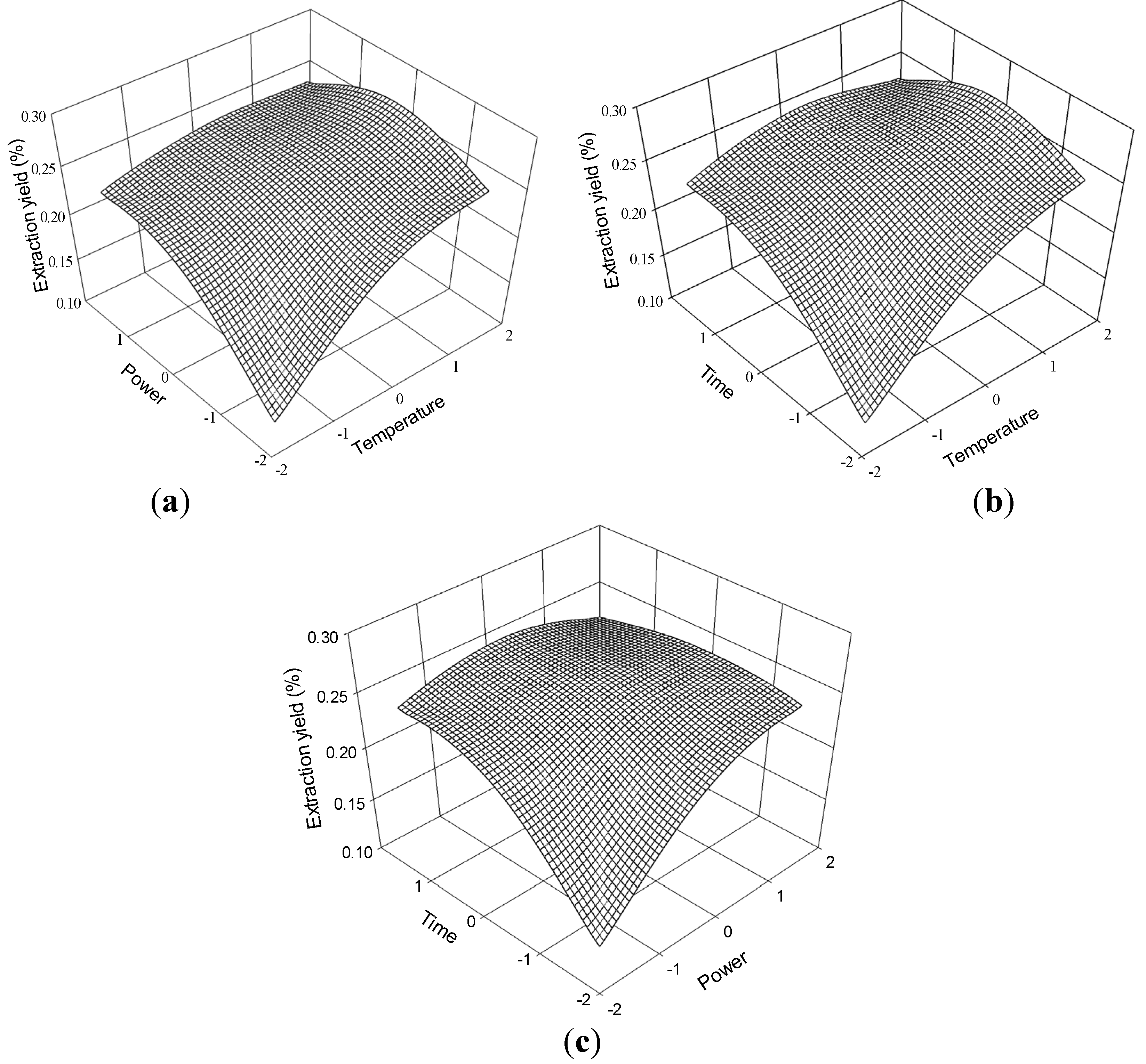
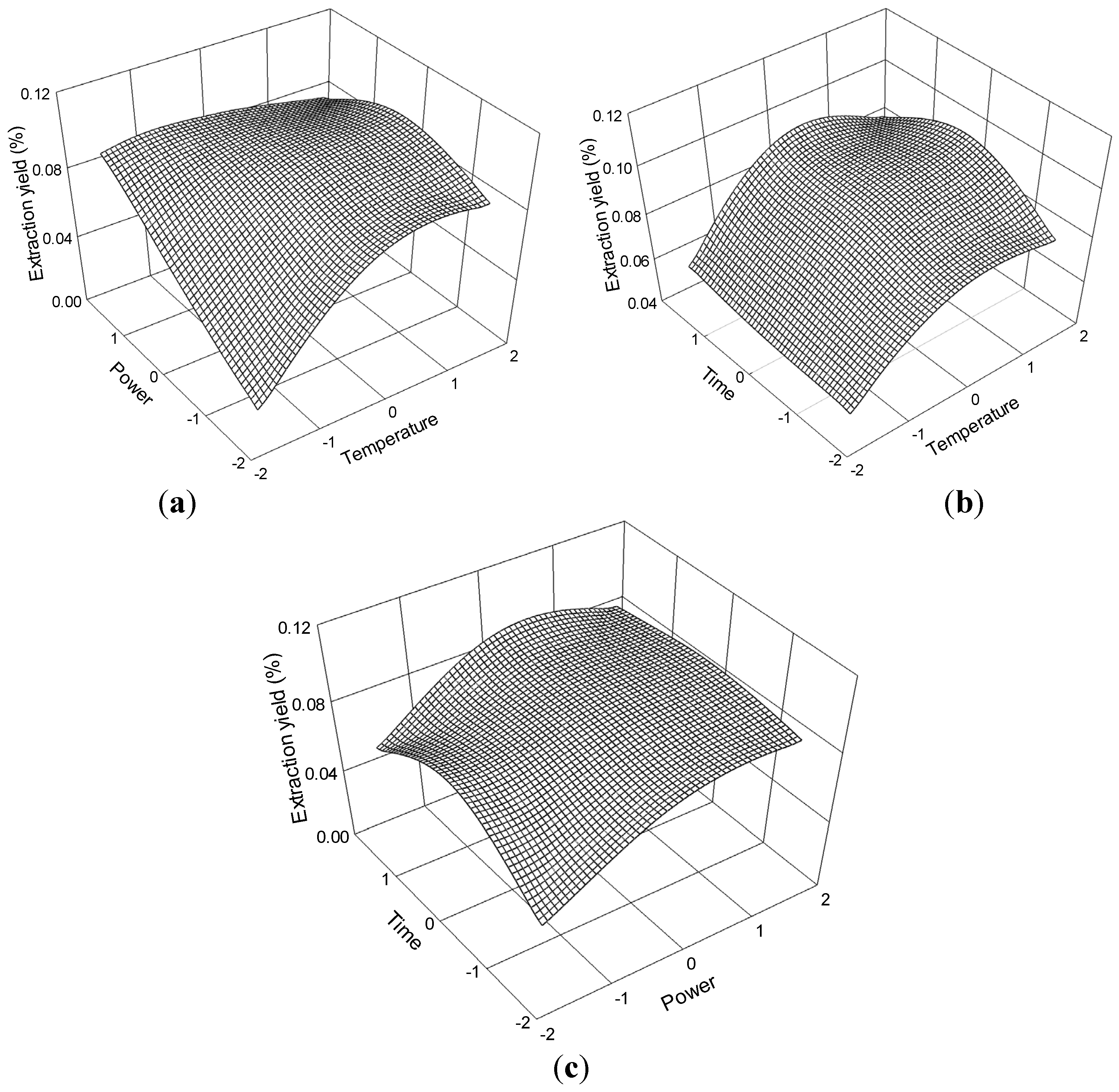
2.2.3. Effect of Process Variables on the Extraction Yield of Senkyunolide H
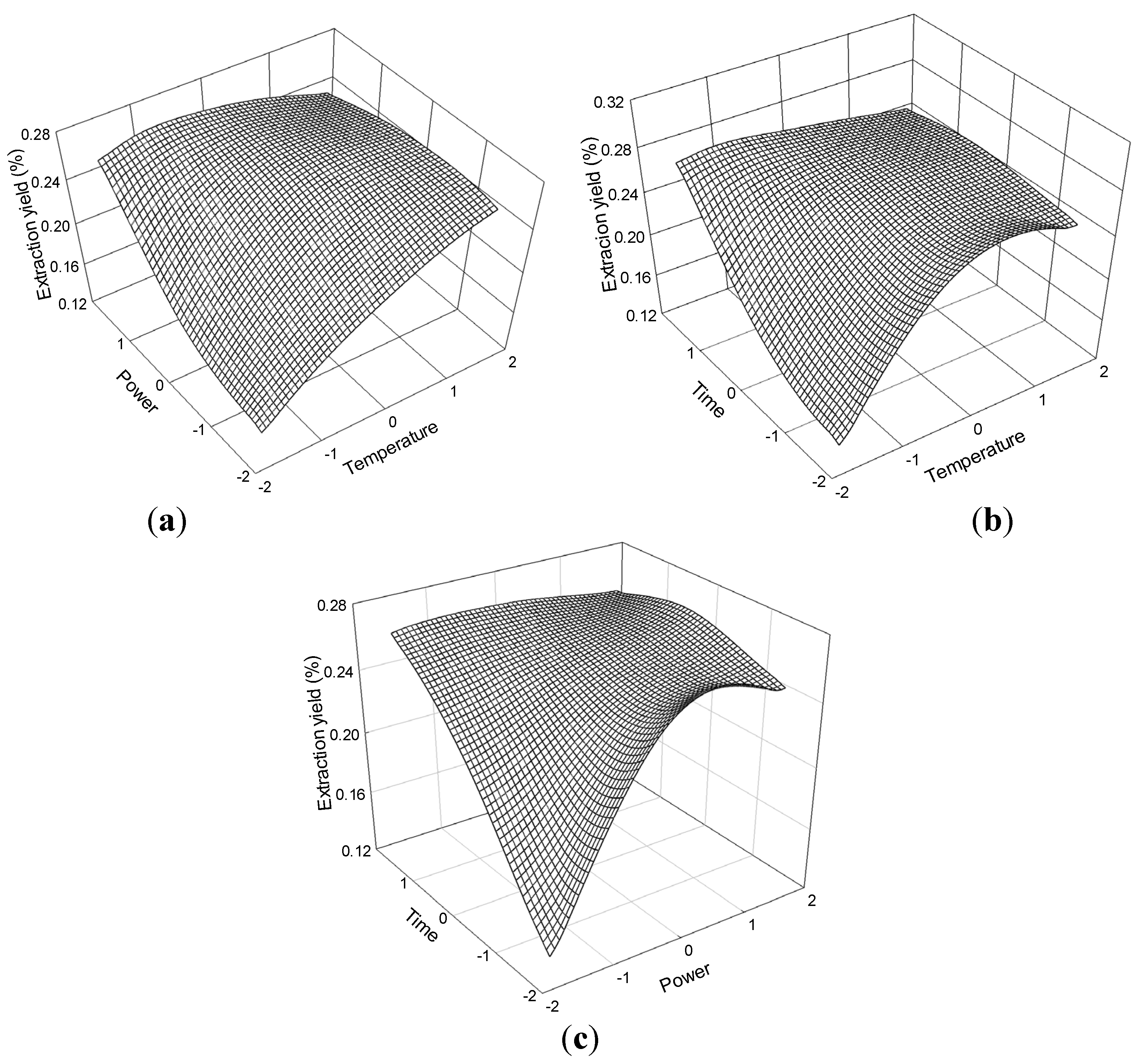
2.2.4. Effect of Process Variables on the Extraction Yield of Senkyunolide A
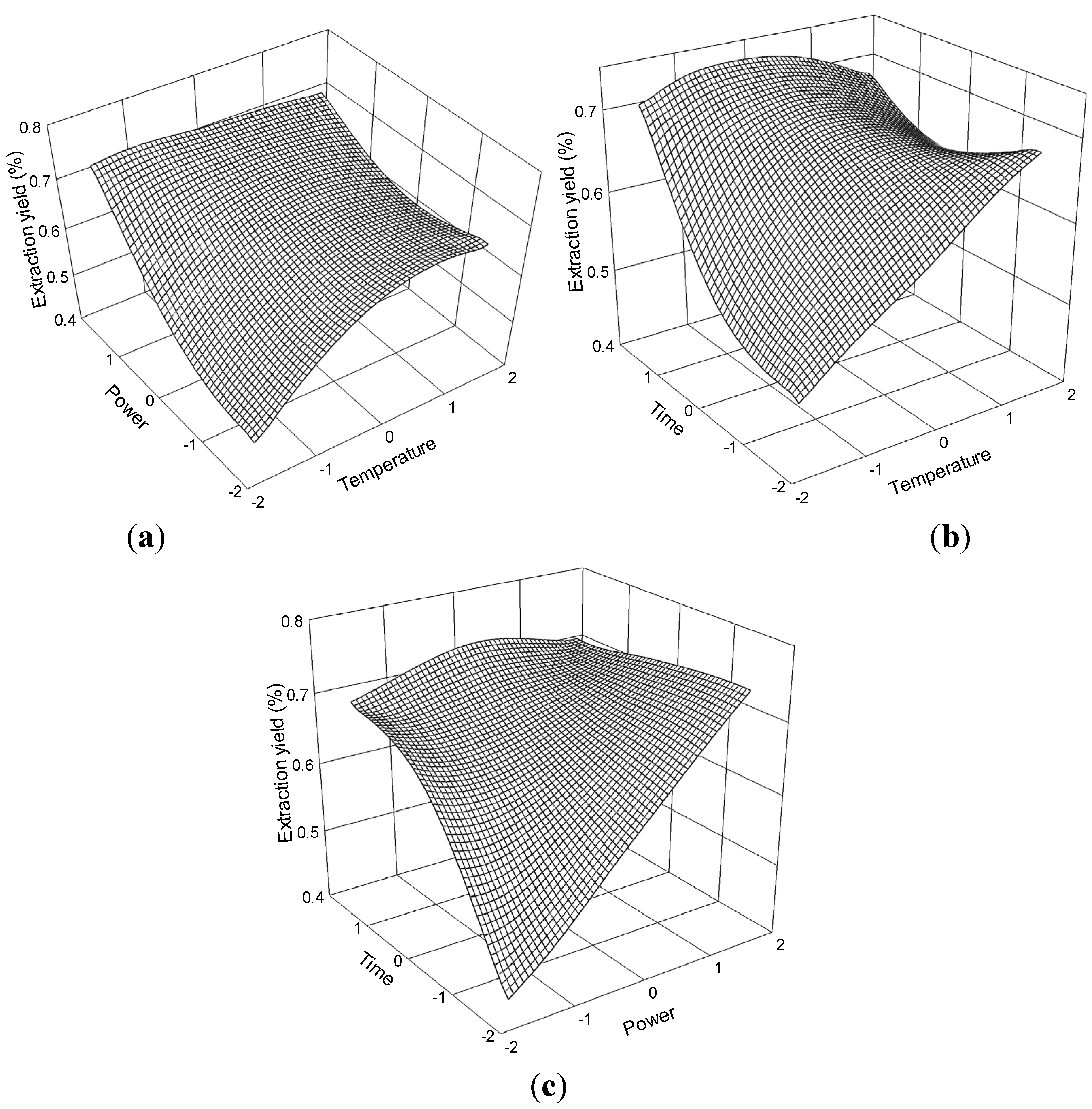
2.2.5. Effect of Process Variables on the Extraction Yield of Ligustilide
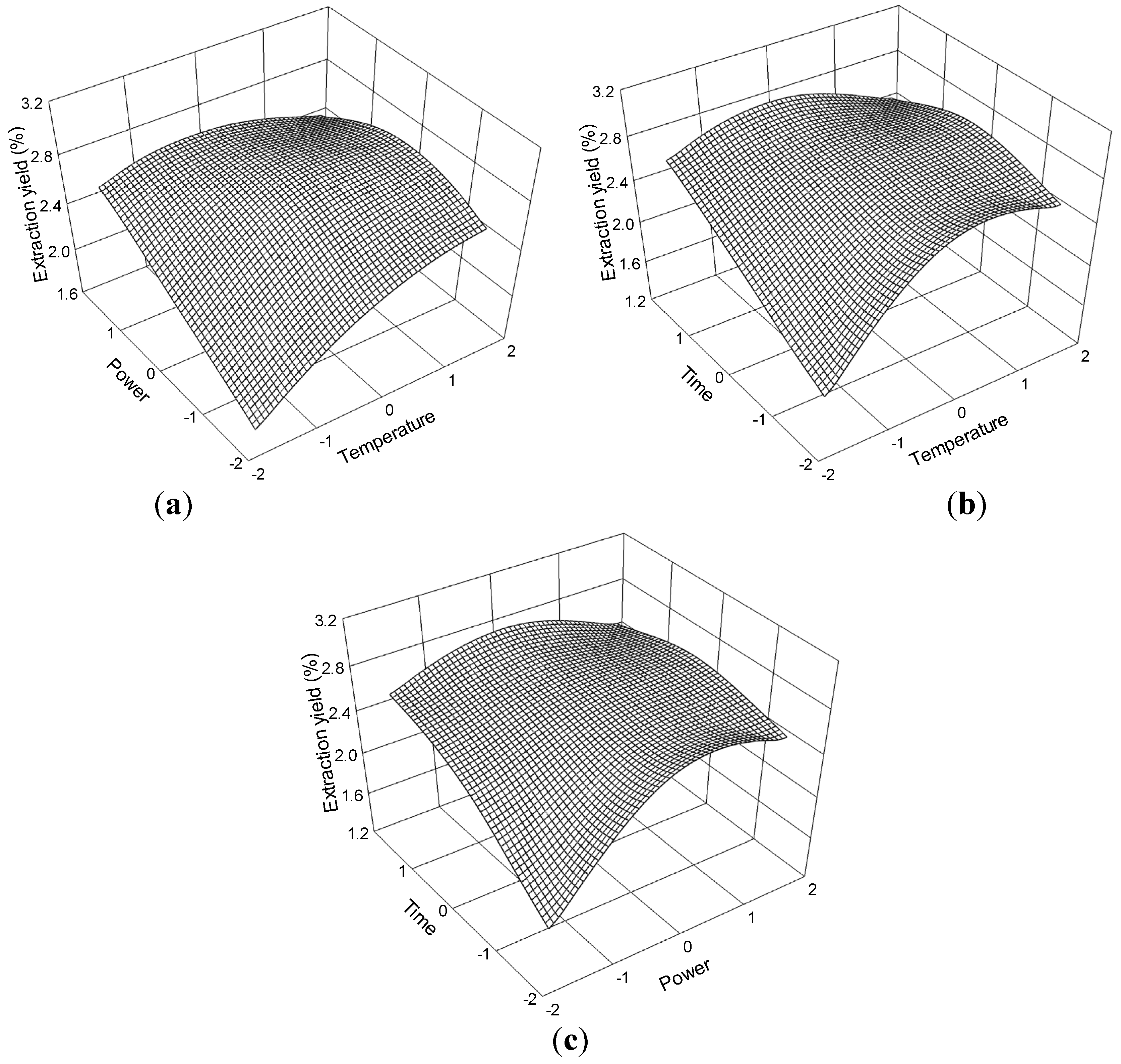
2.2.6. Effect of Process Variables on the Extraction Yield of Levistolide A
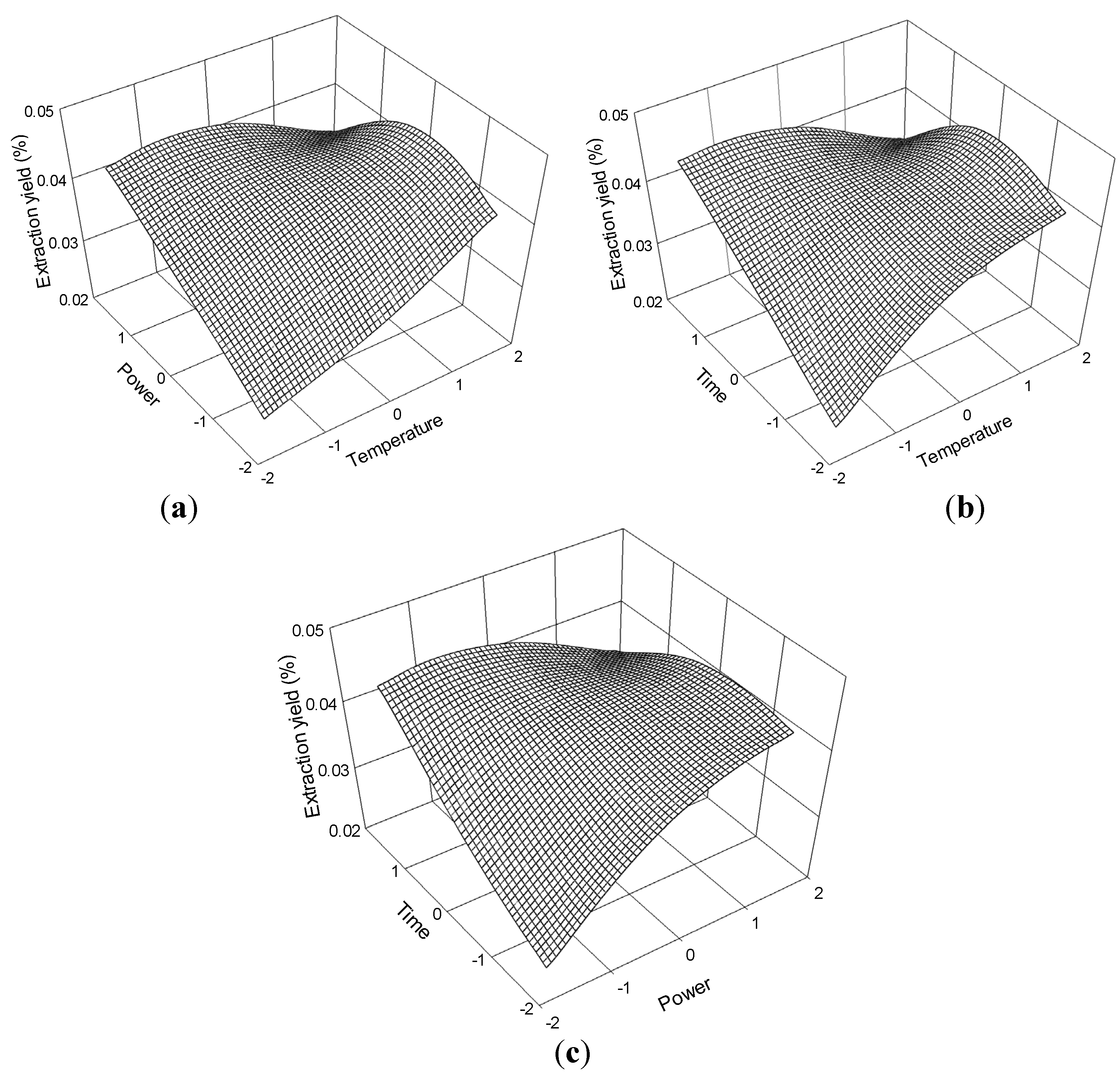
2.3. Optimization of the Extraction Process
| Response variables | Optimum extraction conditions (obtained from equation) | Maximum extraction yields (%) | Extraction yields at optimal conditions from statistical frequency method (%) | |||
|---|---|---|---|---|---|---|
| Temperature (°C) | Ultrasonic power (W) | Time (min) | Predicted | Actual | ||
| Ferulic acid | 77 (76.7) | 195 (195.3) | 64 (64.1) | 0.27 | 0.27 | 0.27 ns |
| Senkyunolide I | 65 (65.3) | 187 (186.8) | 62 (61.5) | 0.09 | 0.09 | 0.09 ns |
| Senkyunolide H | 60 (59.5) | 205 (205.0) | 75 (75.2) | 0.26 | 0.27 | 0.27 ns |
| Senkyunolide A | 64 (63.6) | 200 (200.4) | 67 (66.6) | 0.73 | 0.73 | 0.69 ** |
| Ligustilide | 66 (65.9) | 184 (183.8) | 71 (70.8) | 2.74 | 2.76 | 2.75 ns |
| Levistolide A | 61 (61.4) | 185 (185.0) | 74 (74.2) | 0.04 | 0.04 | 0.04 ns |
3. Experimental
3.1. General Information
3.2. HPLC Quantitative Analysis of the Six Major Constituents
3.3. Single Factor Tests
3.3.1. Solvent Selection
3.3.2. Pressure Selection
3.3.3. Particle Size Selection
3.3.4. Liquid-to-Solid Ratio Selection
3.3.5. Extraction Temperature Selection
3.3.6. Ultrasonic Power Selection
3.3.7. Extraction Time Selection
3.4. Central Composite Design

| Independent variables | Units | Range and Level | ||||
|---|---|---|---|---|---|---|
| 1.682(α) | 1 | 0 | −1 | 1.682(−α) | ||
| Extraction Temperature (X1) | °C | 77 | 70 | 60 | 50 | 43 |
| Ultrasonic Power (X2) | W | 217.5 | 200 | 175 | 150 | 132.5 |
| Extraction Time (X3) | min | 87 | 80 | 70 | 60 | 53 |
4. Conclusions
Acknowledgments
Author Contributions
Conflicts of Interest
References
- Chinese Pharmacopoeia Committee. Chinese Pharmacopoeia; Chemical Industry Press: Beijing, China, 2010; Part 1; p. 38. [Google Scholar]
- Hou, Y.Z.; Zhao, G.R.; Yuan, Y.J.; Zhu, G.G.; Hiltunen, R. Inhibition of rat vascular smooth muscle cell proliferation by extract of Ligusticum chuanxiong and Angelica sinensis. J. Ethnopharmacol. 2005, 100, 140–144. [Google Scholar] [CrossRef]
- Kim, E.Y.; Rhyu, M.R. Synergistic vasorelaxant and antihypertensive effects of Ligusticum wallichii and Angelica gigas. J. Ethnopharmacol. 2010, 130, 545–551. [Google Scholar] [CrossRef]
- Li, W.; Tang, Y.; Chen, Y.; Duan, J.A. Advances in the chemical analysis and biological activities of chuanxiong. Molecules 2012, 17, 10614–10651. [Google Scholar] [CrossRef]
- Tang, Y.; Zhu, M.; Yu, S.; Hua, Y.; Duan, J.A.; Su, S.; Zhang, X.; Lu, Y.; Ding, A. Identification and comparative quantification of bio-active phthalides in essential oils from si-wu-tang, fo-shou-san, radix angelica and rhizoma chuanxiong. Molecules 2010, 15, 341–351. [Google Scholar] [CrossRef]
- Zou, K.M. Study of ferulic acid extraction processes in Chuanxiong. Mod. Tradit. Chin. Med. 2005, 3, 59. [Google Scholar]
- Yang, X.D.; Wu, X.; Hu, L.C.; Guo, H.N. Effect of different solvents on extraction of effective components from Ligusticum chuanxiong. Chin. J. Chin. Mater. Med. 2012, 37, 1942–1945. [Google Scholar]
- Yi, T.; Leung, K.S.Y.; Lu, G.H.; Chan, K.; Zhang, H. Simultaneous qualitative and quantitative analyses of the major constituents in the rhizome of Ligusticum Chuanxiong using HPLC-DAD-MS. Chem. Pharm. Bull. 2006, 54, 255–259. [Google Scholar] [CrossRef]
- Sun, Y.; Wang, W. Ultrasonic extraction of ferulic acid from Ligusticum chuanxiong. J. Chin. Chem. Eng. 2008, 39, 653–656. [Google Scholar]
- Yang, L.; Luo, X.X.; Wang, S.W.; Wang, J.B. The extraction technology for ferulic acid for Angelica Sinensis (Oliv.) Diels and Ligusticum Chuanxiong Hort. by orthogonal design. J. Yunnan Coll. Tradit. Chin. Med. 2007, 30, 14–16. [Google Scholar]
- Cui, L.J.; Liu, Y.M. Optimization of the extraction processes for ferulic acid from Ligusticum Chuanxiong Hort. Qilu Pharm. Aff. 2005, 24, 560–561. [Google Scholar]
- Qin, H.Y.; Wang, W.; Suo, Z.R. Study of ferulic acid extraction processes in Chuanxiong. Chin. New Technol. Prod. 2009, 18, 19. [Google Scholar]
- Tong, S.S. Optimization of extraction processes in Chuanxiong. Heilongjiang Sci. Technol. Inform. 2012, 21, 41. [Google Scholar]
- Yang, G.D.; Liang, M.J.; He, L.C.; Lu, Y.B. Solvent extraction methods of ferulic acid in Ligusticum Chuanxiong Hort. Chin. Tradit. Pat. Med. 2002, 24, 418–420. [Google Scholar]
- Huang, G.X.; Ji, F.; Yang, W.D. Study on the extraction process of ferulic acid from Ligusticum chuanxiong. Chin. JMAP 2007, 24, 203–205. [Google Scholar]
- Li, X.Y.; Lan, X.Q.; Fu, C.; Song, H. Study of major constituents extraction and separation in Chuanxiong. Chin. Tradit. Pat. Med. 2009, 31, 217–220. [Google Scholar]
- Hu, J.; Feng, L.L.; Cui, F.D. The extraction technology for ferulic acid for Angelica sinensis (Oliv.) Diels and Ligusticum chuanxiong Hort. Lishizhen Med. Mat. Med. Res. 2004, 15, 732–733. [Google Scholar]
- Bai, H.B.; Wang, J.F.; Song, Z.R. Study on optimizing the extraction process of ferulic acid and ligustilide in Ligusticum Chuanxiong Hort. Chin. J. Exp. Tradit. Med. Form. 2003, 9, 8–10. [Google Scholar]
- Zhu, J.X.; He, W.; Li, Y.; Yao, X. Optimization extraction processes of ligustilide from Chuanxiong using RSM. Chin. Tradit. Pat. Med. 2011, 33, 2172–2175. [Google Scholar]
- Cao, J.M.; Wang, Z.H.; Sun, G.P.; Ding, M.Y.; Yang, X.D.; Kou, H.J. Study on extraction and separation method of lactone in Chuanxiong. Chin. J. Anal. Lab. 2005, 24, 59–62. [Google Scholar]
- Yansheng, C.; Zhida, Z.; Changping, L.; Qingshan, L.; Peifang, Y.; Welz-Biermann, U. Microwave-assisted extraction of lactones from Ligusticum chuanxiong Hort. using protic ionic liquids. Green Chem. 2011, 13, 666–670. [Google Scholar]
- Fan, S.L.; Zhang, J.J.; Xiong, D.S.; Zhang, C.G. Study on microwave-assisted extraction technology of Rhizoma Chuanxiong. Chin. J. Exp. Tradit. Med. Form. 2011, 17, 46–48. [Google Scholar]
- Fan, J.P.; Cao, J.; Zhang, X.H.; Huang, J.Z.; Kong, T.; Tong, S.; Tian, Z.Y.; Xie, Y.L.; Xu, R.; Zhu, J.H. Optimization of ionic liquid based ultrasonic assisted extraction of puerarin from Radix Puerariae Lobatae by response surface methodology. Food Chem. 2012, 135, 2299–2306. [Google Scholar] [CrossRef]
- Sahin, S.; Samli, R. Optimization of olive leaf extract obtained by ultrasound-assisted extraction with response surface methodology. Ultrason. Sonochem. 2013, 20, 595–602. [Google Scholar] [CrossRef]
- Mujeeb, M.; Alam, S.; Akhtar, M.; Najmi, A.K.; Aqil, M.; Vismail, M. Optimization of ultrasonic-assisted extraction of embelin from embelia ribes using response surface methodology. Planta Med. 2013, 79, 25. [Google Scholar]
- Wang, L.; Wang, Z.; Li, X. Optimization of ultrasonic-assisted extraction of phenolic antioxidants from Malus baccata (Linn.) Borkh. using response surface methodology. J. Sep. Sci. 2013, 36, 1652–1658. [Google Scholar] [CrossRef]
- Yang, L.; Liu, Y.; Zu, Y.G.; Zhao, C.J.; Zhang, L.; Chen, X.Q.; Zhang, Z.H. Optimize the process of ionic liquid-based ultrasonic-assisted extraction of aesculin and aesculetin from Cortex fraxini by response surface methodology. Chem. Eng. J. 2011, 175, 539–547. [Google Scholar]
- Zhang, G.; He, L.; Hu, M. Optimized ultrasonic-assisted extraction of flavonoids from Prunella vulgaris L. and evaluation of antioxidant activities in vitro. Innov. Food Sci. Emerg. 2011, 12, 18–25. [Google Scholar] [CrossRef]
- Yang, L.; Cao, Y.L.; Jiang, J.G.; Lin, Q.S.; Chen, J.; Zhu, L. Response surface optimization of ultrasound-assisted flavonoids extraction from the flower of Citrus aurantium L. var. amara Engl. J. Sep. Sci. 2010, 33, 1349–1355. [Google Scholar]
- Tabaraki, R.; Nateghi, A. Optimization of ultrasonic-assisted extraction of natural antioxidants from rice bran using response surface methodology. Ultrason. Sonochem. 2011, 18, 1279–1286. [Google Scholar] [CrossRef]
- Zou, Y.; Chen, X.; Yang, W.; Liu, S. Response surface methodology for optimization of the ultrasonic extraction of polysaccharides from Codonopsis pilosula Nannf.var.modesta L.T.Shen. Carbohyd. Polym. 2011, 84, 503–508. [Google Scholar] [CrossRef]
- Prasad, K.N.; Hassan, F.A.; Yang, B.; Kong, K.W.; Ramanan, R.N.; Azlan, A.; Ismail, A. Response surface optimisation for the extraction of phenolic compounds and antioxidant capacities of underutilised Mangifera pajang Kosterm. peels. Food Chem. 2011, 128, 1121–1127. [Google Scholar] [CrossRef]
- Sirisompong, W.; Jirapakkul, W.; Klinkesorn, U. Response surface optimization and characteristics of rambutan (Nephelium lappaceum L.) kernel fat by hexane extraction. LWT-Food Sci. Technol. 2011, 44, 1946–1951. [Google Scholar] [CrossRef]
- Euterpio, M.A.; Cavaliere, C.; Capriotti, A.L.; Crescenzi, C. Extending the applicability of pressurized hot water extraction to compounds exhibiting limited water solubility by pH control: Curcumin from the turmeric rhizome. Anal. Bioanal. Chem. 2011, 401, 2977–2985. [Google Scholar] [CrossRef]
- Gan, C.Y.; Latiff, A.A. Optimisation of the solvent extraction of bioactive compounds from Parkia speciosa pod using response surface methodology. Food Chem. 2011, 124, 1277–1283. [Google Scholar] [CrossRef]
- Kong, K.W.; Ismail, A.R.; Tan, S.T.; Prasad, K.M.N.; Ismail, A. Response surface optimisation for the extraction of phenolics and flavonoids from a pink guava puree industrial by-product. Int. J. Food Sci. Technol. 2010, 45, 1739–1745. [Google Scholar] [CrossRef]
- Goretti, M.; Branda, E.; Turchetti, B.; Cramarossa, M.R.; Onofri, A.; Forti, L.; Buzzini, P. Response surface methodology as optimization strategy for asymmetric bioreduction of (4S)-(+)-carvone by Cryptococcus gastricus. Bioresour. Technol. 2012, 121, 290–297. [Google Scholar] [CrossRef]
- Guo, J.; Zhuang, Y.; Chen, L.; Liu, J.; Li, D.; Ye, N. Process optimization for microwave-assisted direct liquefaction of Sargassum polycystum C.Agardh using response surface methodology. Bioresour. Technol. 2012, 120, 19–25. [Google Scholar] [CrossRef]
- Xin, C.; Yin, L.; cheng, D.G.; jian, C. Application of response surface methodology in medium optimization for spore production of Coniothyrium minitans in solid state fermentation. World J. Microb. Biot. 2005, 21, 593–599. [Google Scholar] [CrossRef]
- Lim, J.S.; Park, M.C.; Lee, J.H.; Park, S.W.; Kim, S.W. Optimization of culture medium and conditions for neofructo oligosaccharides production by Penicillium citrinum. Eur. Food Res. Technol. 2005, 221, 639–644. [Google Scholar] [CrossRef]
- Gohel, V.; Jiwan, D.; Vyas, P.; Chatpar, H.S. Statistical optimization of chitinase production by Pantoea dispersa to enhance degradation of crustacean chitin waste. J. Microbiol. Biotechnol. 2005, 15, 197–201. [Google Scholar]
- Rodrigues, R.C.; Kenealy, W.R.; Dietrich, D.; Jeffries, T.W. Response surface methodology (RSM) to evaluate moisture effects on corn stover in recovering xylose by DEO hydrolysis. Bioresour. Technol. 2012, 108, 134–139. [Google Scholar] [CrossRef]
- Wang, Y.; Blaschek, H.P. Optimization of butanol production from tropical maize stalk juice by fermentation with Clostridium beijerinckii NCIMB 8052. Bioresour. Technol. 2011, 102, 9985–9990. [Google Scholar] [CrossRef]
- Li, S.L.; Chan, S.S.; Lin, G.; Ling, L.; Yan, R.; Chung, H.S.; Tam, Y.K. Simultaneous analysis of seventeen chemical ingredients of Ligusticum chuanxiong by on-line high performance liquid chromatography-diode array detector-mass spectrometry. Planta Med. 2003, 69, 445–451. [Google Scholar]
- Chen, Q.H.; Fu, M.L.; Liu, J.; Zhang, H.F.; He, G.Q.; Ruan, H. Optimization of ultrasonic-assisted extraction (UAE) of betulin from white birch bark using response surface methodology. Ultrason. Sonochem. 2009, 16, 599–604. [Google Scholar]
- Ming, D.X. Advanced Biostatistics; Agricultural Press: Beijing, China, 2006; pp. 129–252. [Google Scholar]
- Sample Availability: Samples of the Chuanxiong are available from the authors (L. chuanxiong Hort. rhizomes were collected from Dujiangyan County, Chengdu City, Sichuan Province, China).
© 2014 by the authors. Licensee MDPI, Basel, Switzerland. This article is an open access article distributed under the terms and conditions of the Creative Commons Attribution license ( http://creativecommons.org/licenses/by/3.0/).
Share and Cite
Liu, J.-L.; Zheng, S.-L.; Fan, Q.-J.; Yuan, J.-C.; Yang, S.-M.; Kong, F.-L. Optimization of High-Pressure Ultrasonic-Assisted Simultaneous Extraction of Six Major Constituents from Ligusticum chuanxiong Rhizome using Response Surface Methodology. Molecules 2014, 19, 1887-1911. https://doi.org/10.3390/molecules19021887
Liu J-L, Zheng S-L, Fan Q-J, Yuan J-C, Yang S-M, Kong F-L. Optimization of High-Pressure Ultrasonic-Assisted Simultaneous Extraction of Six Major Constituents from Ligusticum chuanxiong Rhizome using Response Surface Methodology. Molecules. 2014; 19(2):1887-1911. https://doi.org/10.3390/molecules19021887
Chicago/Turabian StyleLiu, Jin-Liang, Shun-Lin Zheng, Qiao-Jia Fan, Ji-Chao Yuan, Shi-Min Yang, and Fan-Lei Kong. 2014. "Optimization of High-Pressure Ultrasonic-Assisted Simultaneous Extraction of Six Major Constituents from Ligusticum chuanxiong Rhizome using Response Surface Methodology" Molecules 19, no. 2: 1887-1911. https://doi.org/10.3390/molecules19021887
APA StyleLiu, J.-L., Zheng, S.-L., Fan, Q.-J., Yuan, J.-C., Yang, S.-M., & Kong, F.-L. (2014). Optimization of High-Pressure Ultrasonic-Assisted Simultaneous Extraction of Six Major Constituents from Ligusticum chuanxiong Rhizome using Response Surface Methodology. Molecules, 19(2), 1887-1911. https://doi.org/10.3390/molecules19021887




